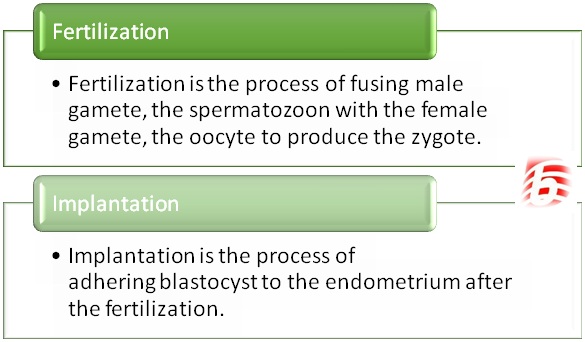Difference Between Fertilization and Implantation
Fertilization vs Implantation
The key difference between fertilization and implantation is that they two are different stages in the fetal development process. In this article, the two processes, fertilization and implantation, and the difference between them will be discussed in detail. Both fertilization and implantation are crucial stages of fetal development or pregnancy. Fatal development starts with a fertilized egg (ovum) and ends with a fully developed fetus. Fertilization and implantation are early developmental stages of this process. In each period, the fetus is denoted by a different name. For example, the period starting from ovulation to fertilization, it is called ovum, whereas the period of fertilization to implantation, the fetus is denoted as zygote. Fertilization occurs first followed by implantation and usually both stages are completed within the first 8-10 days from the beginning of pregnancy.
What is Fertilization?
Fertilization is the process of fusing male gamete, the spermatozoon, with the female gamete, the oocyte, to produce the zygote. Fertilization occurs within 24 hours of ovulation in the ampulla, the most widened part of the fallopian tube. This process begins when the sperms enter into the vagina. Once the sperms are placed in the vagina, they migrate through the cervix to the uterine tube with the help of the movement of their flagella. Sperms can, usually, stay viable for several days in the female genital tract, but the oocyte lasts up to about 24 hours. Hence, intercourse must occur between 3 days before and one day after ovulation for a successful fertilization. Although many sperm cells reach the oocyte, only one will penetrate the membranes of oocyte to produce the zygote. Once the sperm cell reaches inside the oocyte, second meiotic division occurs in the oocyte, resulting haploid nucleus. The nucleus then fuses with the haploid nucleus of sperm cell to form the zygote. This fusion finally completes the process of fertilization.
Also, read: Difference Between External and Internal Fertilization, Difference Between Spermatogenesis and Oogenesis
What is Implantation?
Implantation is the process of adhering blastocyst to the endometrium after the fertilization. It takes place after about 8-10 days of fertilization. The trophoblast cells located outside of the blastocyst can produce proteolytic enzymes that are able to dissolve any tissue, which they touch. This action allows blastocyst to invade into endometrium. Implantation causes several changes to blastocyst, trophoblast and uterus. As invasion continuous, the blastocyst differentiates to form three germ layers namely; endoderm, ectoderm and mesoderm. The trophoblast that are embedded in the endometrium lately form the chorion and a part of the placenta. During the implantation, the endometrium becomes thicker, soft and highly vascular in order to support the developing embryo. Under normal conditions, the implantation, usually, occurs on the anterior or posterior walls of the uterus. However, if the implantation occurs at sites closer to internal os of the cervix, it will lead to the abnormal condition called placenta previa.

What is the difference between Fertilization and Implantation?
• Fertilization is the fusion of male and female gametes to form a zygote. Implantation is the process of adhering blastocyst to the endometrium.
• Fertilization occurs followed by the implantation.
• Fertilization occurs within about 24 hours of ovulation whereas implantation occurs after about 8-10 days of fertilization.
• Fertilization ends with zygote whereas implantation results implanted blastocysts with three germ layers.
• Fertilization occurs in the widened part of fallopian tube, which is very closer to ovary, whereas implantation occurs in the endometrium of the uterus.
ncG1vNJzZmivp6x7pbXFn5yrnZ6YsqOx07CcnqZemLyue8OinZ%2Bdopq7pLGMm5ytr5Wau26yxKuroqSZr661tc6nZJqmlGLDtHnIpqelmZ6prrW1zqdm